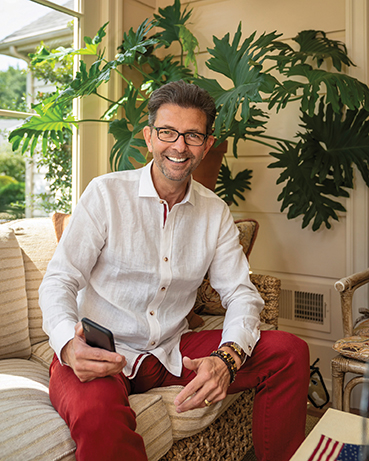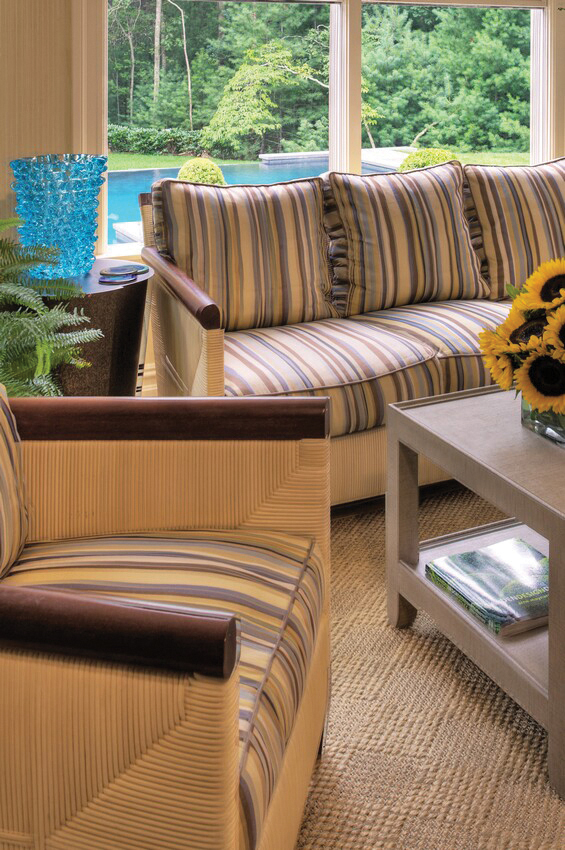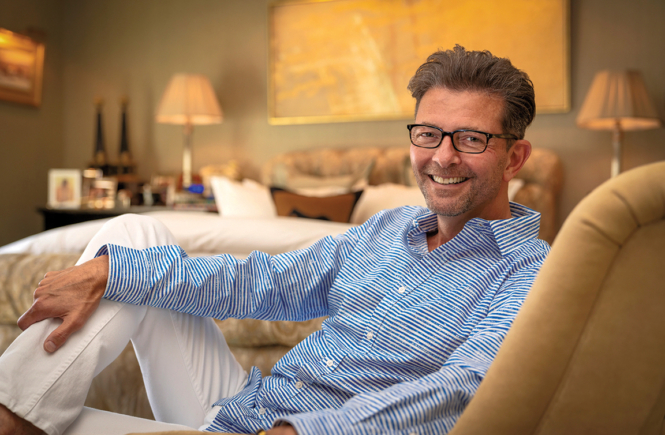Interior designer Jeffrey Parker’s talents have taken him across the globe, but his heart and his home are on the Eastern Shore
Intro and Interview by Jonathan Westman
Portraits by Ted Mueller | Interior Photos by Tom Sibley
From Palm Beach to Paris, the Middle East to East Hampton, and dozens of other celebrated points around the world, Jeffrey Parker’s interior design projects have produced glowing reviews and a quintessential reputation for deeply connecting with his clients to discover their tastes and lifestyles — a responsibility he says is crucial in the execution of great design. The Cambridge native and University of Maryland graduate founded his firm, Jeffrey Parker Interiors, in New York City in 1998 and has hundreds of illustrious designs to his credit. He returned to the Shore in 2012, purchased a home in Easton’s Cooke’s Hope and quickly reestablished his roots. Jeffrey is a trustee of the Academy Art Museum, served for years on the Choral Arts Society board and is completing his fourth year as chairman of the Mid-Atlantic Symphony Orchestra Board. Today, he divides his time between Easton and Manhattan.
JW: One could walk into six different “coastal” designed homes, and all could look very different from one another. What is your definition of “coastal” from an interior design perspective?
JP: That’s a very interesting question. People have different tastes and aesthetic priorities. Coastal style can be so much more than a cliché, and I think over the years, the concept of coastal style has gotten pigeonholed into something that has to do with mass-produced sailboat models, crab motifs and seashells. I would like to think that at this point in all of our taste-and-design evolutions, we’ve come to realize that coastal style can be something much more than that. While you can never lose sight of the practicalities of, for instance, living at the beach, living with high humidity levels, windows open, sand at your feet, yet at the same time, I think you can have a level of luxury, a level of comfort and an expression of individual tastes that go beyond the cliché. There are so many aspects of the local environment that can inspire our designs – it’s an opportunity to pause with your client and say, “What makes you want to wake up here, to live here?”
I had one project in which the entire apartment was designed based on how beautiful the almost-daily sunset appeared. It was a combination of orange, magenta and purple — a kind of dusty mixture of the colors. The whole apartment became this rose-and-mauve kind of lavender, with accents of purple. It was absolutely stunning. Every evening this sunset occurred, it absolutely complemented everything that was going on in the apartment. So, at its core, coastal style is very individual, and it should be very personal.

JW: What elements are a must in a coastal design that Jeffrey Parker Interiors is directing?
JP: For me, it’s always been important to have the integration of artwork in my interior design projects. Some of the most essential things in a room, for me, are the artwork, lighting, the use of comfortable fabrics that feel good, whether it’s a particular cut velvet, a particular Chenille, a linen-cotton blend woven texture that feels approachable to the touch. Every element should feel usable: I want to walk into a room and see comfortable furniture — both sofas and chairs that are inviting — whether it’s to have a drink with friends or to watch a movie together.
As an interior designer, I believe people are born with predispositions toward certain fields. It may be chemistry. It may be mathematics. It may be music. It may be art. For me, I’ve always had a passion for beauty and for lifestyle, and I use the word lifestyle because interior design doesn’t start and stop with furniture, colors and fabrics for me whatsoever. In fact, architecture very much informs all of my design processes. I’ve studied architecture and have a passion for both architecture and design. That’s essential for me, but as essential as architecture and design, beauty and lovely fabrics are to me, so are lighting, music and artwork — it’s really a complete package.
What I want to offer to my clients ultimately is a lifestyle package. I want to walk into the room and hear music, whether it’s a tinkling piano playing jazz music in the evening, a symphony playing in the background softly or someone crooning ballads, like Ella Fitzgerald or Sarah Vaughan. It adds a totally different dimension to a room. And I think it informs interior design. For me, lighting, music, artwork, fabrics and architectural backgrounds are the five essential elements of design. A room should stimulate — or calm — ALL of our senses. Enter a beautiful room, enjoy some food and a drink, and our five senses should be satiated — and we should have a perception that “all is right with the world.” With this, your design is a complete success.
“For me, lighting, music, artwork, fabrics and architectural backgrounds are the five essential elements of design.”
— Jeffrey Parker
JW: How does your approach change when designing the interior of a beach home?
JP: If you’re down at the beach, that’s different. Even what coastal living is to people is so varied. Is coastal living a beautiful home on a golf course or is it on the beach? I think you approach interior design very differently, even in those two scenarios. If you’re in a beach house, I think it’s even more important that things be beach-and-water-friendly. That could call for very casual, very durable fabrics; perhaps it even calls for the use of indoor-outdoor fabrics in the interior on a sofa, for example. Today there are so many luxurious indoor/outdoor fabrics available. If you’re coming off the golf course to a home in a golf community, there’s a certain type of upholstery fabric that you might choose differently than if you are coming in from a walk along the ocean. I think you can go up a notch, to where things are less water-resistant and fragile but still very relaxed and comfortable. So, number one, the key for me is appropriate fabrics that are approachable, comfortable and practical, depending on the environment they’re placed in.
JW: How vital is the connection between designer and client?
JP: That relationship is crucial. I very much try to get to know my clients — and one of the key things I like to do is look into their closets to see how they dress, how they accessorize, see how they live. Are these people who like color, or do these people prefer the absence of color? There is no right or wrong, but I want to put my clients in an environment that’s comfortable for them to live in. When their friends come over in the evening, I don’t want them to say, “This is a Jeffrey Parker Interior.” I want them to experience the space and say, “My goodness, this place is beautiful.” And I want it to be a reflection of my client’s tastes, raised to a highest possibility.


JW: What advice would you share with readers who want to update the interiors of their homes?
JP: Work with a design professional and make a plan. I’ve said this to my clients for years: “Make a plan for your home.” It can be a five-year plan. Take your time in executing it and choose your priorities. Do you do the living room first, or do you start with a new kitchen and a new bathroom first? Prioritize your goals and make a plan, because five years will come and go before you blink. And if you stick to a plan, in five years, you will have a beautifully completed residence that will have longevity and style that will endure.

